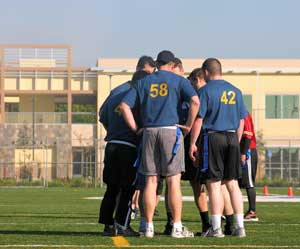Our laboratory holds a daily patient safety huddle, and it has led to tremendous improvements in accountability, respect, and teamwork. In fact, the huddle is my favorite part of the workday. We report patient safety issues from our laboratory huddle, and if they are severe enough, we report them to our hospital leadership's safety huddle. This new team concept not only promotes greater patient safety, but it also raises awareness of how important the laboratory is to patient health and healthcare.
Huddle Participants and Frequency
The first step in developing a huddle is making sure the right people are there. Ideally, participants in the laboratory's huddle should include the administrative director, the medical director, the quality and other managers, supervisors, and doctoral-level directors of the various laboratory divisions. Our quality manager usually leads the huddle. Other divisions also must provide representatives daily: central processing and phlebotomy; core and satellite laboratories; microbiology, chemistry, and biochemical genetics; cell markers and immunology; cytogenetics; molecular diagnostics; anatomic pathology/histology; client services; laboratory information systems; administration, point-of-care; send outs; and blood banking. In total, about 15–20 people attend. Every week, other visitors join us to observe, provide feedback, and learn. Hospital auditors, the hospital vice president, hospital board members, and other trainees and representatives from outside organizations have all been guests of the huddle.
We are a medium-sized laboratory of about 150 full-time equivalents. On weekends, when staffing levels drop, we don't hold huddles. Instead, weekend shifts rely upon communication between the staff on duty, and if needed, our escalation policy. However, a larger laboratory with significant staffing on weekends should consider huddling.
 Is your laboratory struggling to meet the hospital's
Is your laboratory struggling to meet the hospital's
patient safety goals or finding the same problems occur over and over again?
Patient safety huddles are catching on in hospitals just for these reasons.
A daily laboratory patient safety huddle will help your team win.
Just like in football, huddles allow team members to share
information quickly and move the ball to the goal.
Huddle Contents
Managing time is key to making sure the huddle stays focused. Our huddles last no longer than 15 minutes, which means that each division gets a minute or less to report. In practice, divisions with something significant get slightly more time. This is offset by divisions with nothing to report. The huddle takes place in front of a magnetic white board that we call the huddle board. It has green, red, and yellow magnets to succinctly summarize the state of each division. Sometimes, we also add brief, clarifying statements with a marker pen.
The color-coded system gives everybody an immediate feel for the state of the laboratory's operations. It has enough space for a week, so short term trends, such as staffing shortages, are easily detected in each division.
The representative from each division reports whether the division is green, yellow, or red for staffing and then briefly describes any patient safety issue from the previous 24 hours, except on Monday when the entire weekend is included. We consider failure to report a known incident a significant violation of huddle policy and procedure.
In addition, each individual presents any concerns that might affect the next 1–2 days. A report of a patient safety incident or concern must include short-term countermeasures to reduce the likelihood of an occurrence in the next day or two. If the countermeasures are insufficient, the appropriate laboratory leaders provide help after the huddle to ensure an effective countermeasure is implemented. When the team notices that a division reports the same issue frequently, it is moved up to a project level outside the huddle where appropriate individuals can be brought together for more lengthy discussions.
The table presents some examples of reports and countermeasures from daily laboratory patient safety huddles. These include some from my laboratory, as well as from other laboratories that shared their experiences with me.
| Examples of Problems and Countermeasures |
| Problem |
Possible Countermeasure(s) |
| Short staffing |
- Shift staffing hours.
- Shift staffing between laboratory divisions.
- Approve overtime.
- Warn providers about potential delays for nonemergent tests.
|
| Disruptive physician behavior |
- Escalate to hospital's medical director.
|
| Mislabeled specimen |
- Conduct mini root-cause analysis.
- Follow with appropriate response to the root, such as coaching phlebotomist or nurse.
|
| Instrument downtime |
- Call service representative and document service plan and arrival time stated.
- Notify appropriate clinicians.
- Use alternative testing strategy, such as implementing another instrument or sending tests out.
|
| Scheduled LIS downtime |
- Apply downtime procedure.
|
| Recalled test kit |
- Determine potential and actual patient harm.
- Develop alternative testing strategy, such as new kit or send out.
- Notify appropriate providers.
|
| Reagent shortage |
- Find alternative source.
- Find alternative testing strategy, such as different platform or send out.
|
| Data entry error |
- Institute validation by two staff members.
- Interface instrument to laboratory information system.
|
Division representatives with no patient safety issues merely report, "Our division is green for staffing with no barriers." It is also appropriate, and encouraging, to very briefly report that a project focused on an issue frequently raised in the huddle has started. For example, we allow 10-second updates on significant projects, such as a laboratory remodel or a major addition to the test menu. In such cases, the division representative would say, "Project to interface the instrument to reduce data entry errors is green with completion date in three weeks." However, usually about half of the divisions have no patient safety concerns to report on a particular day.
Besides the reports described above, our laboratory patient safety huddle includes a brief report of significant issues from the hospital's daily safety huddle, which is always attended by a senior member of the laboratory staff, such as a medical director, administrative director, or quality manager. Typically, at the end of the huddle there is time for very brief announcements, including a word of thanks for a laboratory member on the person's contribution to patient safety, information about the day's visitors and continuing education opportunities, or a positive word about fundraising activities by the laboratory guild, part of the hospital's fundraising arm. This helps end the meeting on a positive note.
The Cascade of Hospital Huddles
Hospital patient safety huddles now occur at more than 200 hospitals across the U.S. and are fast becoming an important component of daily management. The leaders at daily hospital patient safety huddles represent the major divisions or programs of the hospital such as surgery, inpatient units, ambulatory clinics, infection control, pharmacy, radiology, laboratory, and others. Other leaders in attendance a few times a week are the hospital president, chief nursing officer, chief medical officer, chief safety officer, and vice presidents of various hospital divisions. The leaders of the individual divisions or programs report only the most significant issues from huddles taking place in their area of the hospital.
Ideally, a senior representative of the laboratory huddle presents at the hospital's daily huddle. Examples of problems we escalate to the hospital daily huddle include instrument downtime leading to significant delays or any event involving patient harm. Relevant information also flows in the other direction, too. Issues that our hospital leadership wants all staff to be made aware of cascade down to the laboratory leadership huddle and then to the laboratory division huddle the next day.
In this framework, patient safety huddles embody an escalating system of short meetings starting at the division level and involving staff performing the work who know the safety issues first-hand. It also ensures that only the most important information from the daily huddles escalates to the division's leadership huddle, and then, when significant enough, to the hospital's daily safety huddle.
The Huddle Report Card: A+
Overall, huddles are a terrific way to communicate patient safety issues quickly and efficiently, and they promote teamwork throughout the hospital. Our huddle has been a huge help in making our laboratory operations smoother and safer. Not only does the huddle save time by eliminating less structured meetings, but it also promotes accountability by forcing us to provide short-term countermeasures and making obvious which issues require larger-scale, more permanent patient safety interventions.
We've found that an integral part of these brief meetings is the huddle board. This visual management tool promotes quick assessment of the laboratory's overall operation, and it teaches us to communicate succinctly. The huddle board also encourages teamwork. For example, one day's "green" laboratory divisions can volunteer to shift staff to "red" divisions. Inevitably, on other days, that favor is reciprocated, and the team spirit grows.
Finally, patient safety huddles promote respect among all hospital staff. They raise awareness of problems, both in other laboratory divisions and throughout the hospital. Our laboratory huddles connect us with larger problems in the hospital and end on a positive note. With patient safety huddles, our many burdens are shared, and often at the end of the huddle, a joy is shared and multiplied by all participants.
I am never prouder than when observing staff in our daily laboratory safety huddle! GO TEAM!
SUGGESTED READING
Brady PW, Meuthing S, Kotagal U, et al. Improving situation awareness to reduce unrecognized clinical deterioration and serious safety events. Pediatrics 2013;131:e298–308.
 Michael Astion, MD, PhD, is clinical pathologist and division chief of Laboratory Medicine at Seattle Children's Hospital, Seattle. He is also chair of the Patient Safety Focus Editorial Advisory Board.
Email: [email protected]
Michael Astion, MD, PhD, is clinical pathologist and division chief of Laboratory Medicine at Seattle Children's Hospital, Seattle. He is also chair of the Patient Safety Focus Editorial Advisory Board.
Email: [email protected]